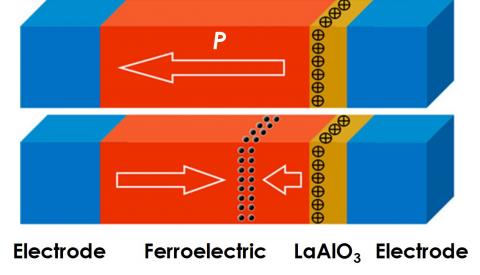Ferroelectric tunnel junctions (FTJs) consist of two metal electrodes separated by a thin ferroelectric barrier layer. The electric resistance of an FTJ changes when the electric polarization of this layer is reversed by an applied voltage. This property, known as the tunneling electroresistance (TER) effect, can be used for applications of FTJs in random-access memories. The enhancement of TER is beneficial for the applications.
Nebraska MRSEC researchers have proposed a new concept to design high-performance FTJs with enhanced TER. This design exploits property of a polar oxide material to create an ionic charge at the interface. When used in a composite barrier, it pins polarization of the adjacent ferroelectric layer which strongly reduces resistance of one of the FTJ states but does not affect the other. Using first-principles calculations, the researchers predicted that an ultrathin lanthanum aluminate (LaAlO3) layer enhances the TER of an FTJ with resistance ratio exceeding a factor of ten thousand. Such enhanced performance of the proposed FTJ can be exploited for device applications.

Schematic showing a ferroelectric tunnel junction (FTJ) with a composite barrier consisting of a ferroelectric layer (red) and a polar lanthanum aluminate (LaAlO3) layer (brown). The LaAlO3 layer creates a positive ionic charge at the interface which pins ferroelectric polarization (P) away from it. This property makes one state having a uniform polarization (top panel) and the other state having a head-to-head polarization (bottom panel). As a result the resistance of the FTJ corresponding to the two polarization states differs significantly, resulting in the enhanced TER effect.